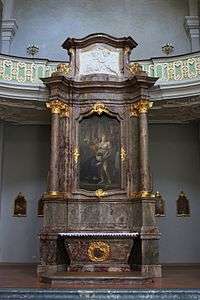Lambert Krahe
Wilhelm Lambert Krahe (15 March 1712, Düsseldorf - 2 November 1790, Düsseldorf) was a German history painter and art collector.
.jpg)

Life
He was the son of a government clerk. Nothing is known of his early education. He found a patron in Ferdinand von Plettenberg, who took Krahe along when he was appointed Imperial Envoy to the Papal Court in 1736. When Plettenberg died suddenly in 1737, Krahe found support from the German Jesuits. He is also said to have worked in the studios of Marco Benefial and Pierre Subleyras.[1] His patrons at that time included Cardinal Alessandro Albani and Johann Joachim Winckelmann. In 1749, upon the recommendation of Silvio Valenti Gonzaga, the Cardinal Secretary of State, he was pensioned to Charles Theodore, Elector of Bavaria, on whose behalf he painted altarpieces for the Jesuit Church in Mannheim. In 1756, he became head of the Düsseldorf Art Gallery.[2][3] Later, the Elector appointed him to oversee the creation of new galleries in Mannheim and Munich. In 1761, he was commissioned to paint ceilings in the library and ballrooms at Schloss Benrath.[4] He started an art school in 1762. Eleven years later, his school was designated the "Electorate of the Palatinate Painting, Sculpture and Architecture Academy" (later, the Kunstakademie Düsseldorf) and Krahe became its first Director. In his last years, an eye ailment prevented him from painting.
The Classical architect Peter Joseph Krahe was his son. Moritz Kellerhoven was one of his best-known students.
His art collection
Although Krahe was a very popular painter in his day, his art collection constitutes his most important achievement. Begun when he was in Rome, and expanded during travels throughout Germany, Holland and France, it came to include 332 paintings and oil sketches, as well as thousands of drawings and prints from the 15th to 18th centuries. It remains one of the world's most important collections of Italian Baroque drawings.
In 1778, the collection was purchased by the Duchy of Berg for use at the Academy. Since 1932, most of it has been on permanent loan from the Academy to the Museum Kunstpalast in Düsseldorf.[5] Smaller selections may be seen at the Wallraf-Richartz Museum in Cologne and the Louvre.
The centerpiece of the collection consists of graphic works by Raphael, Michelangelo and Paolo Veronese, with larger works by Gian Lorenzo Bernini, Pietro da Cortona and Giuseppe Passeri. The collection also includes woodcuts by Albrecht Dürer, engravings by Martin Schongauer and etchings by Rembrandt.
References
- Lambert Krahe und die Kunstakademie Düsseldorf, Artikel im Portal smkp.de des Museums Kunstpalast, retrieved, 24 June 2013
- Ekkehard Mai: Die Düsseldorfer Kunstakademie im 19. Jahrhundert – Cornelius, Schadow und die Folgen. In: Gerhard Kurz (Hrsg.): Düsseldorf in der deutschen Geistesgeschichte, Verlag Schwann-Bagel, Düsseldorf 1984, ISBN 3-590-30244-5, S. 201
- Klaus Müller: Unter pfalz-neuburgischer und pfalz-bayerischer Herrschaft. In: Hugo Weidenhaupt (Hrsg.): Düsseldorf. Geschichte von den Ursprüngen bis ins 20. Jahrhundert. Schwann im Patmos Verlag, Düsseldorf 1988, ISBN 3-491-34222-8, S. 267
- Johann Georg von Vierbahn, in: Topographie des Regierungsbezirks Düsseldorf, Erster Teil, 1836, S. 284.
- Bertram Müller: Lambert Krahes Spürnase für Kunst. Artikel vom 12. April 2013 im Portal rp-online.de, retrieved, 12 April 2013
Further reading
- Moritz Blanckarts (1883), "Krahe, Lambert", Allgemeine Deutsche Biographie (ADB) (in German), 17, Leipzig: Duncker & Humblot, pp. 22–23
- Dieter Graf (1980), "Krahe, Lambert", Neue Deutsche Biographie (NDB) (in German), 12, Berlin: Duncker & Humblot, pp. 657–658; (full text online)
- Bibliothek Lambert Krahe: Kunstliteratur des Barock und des Klassizismus; eine Ausstellung der Universitätsbibliothek Düsseldorf, 14. November 1990 – 12. Januar 1991. Düsseldorf, 1990
- Kunibert Bering: Lambert Krahe (1712–1790). Maler – Sammler – Akademiegründer. In: Artificium – Schriften zur Kunst und Kunstvermittlung, Bd. 43, Athena-Verlag, Oberhausen 2013, ISBN 978-3-89896-531-6
External links
| Wikimedia Commons has media related to Lambert Krahe. |